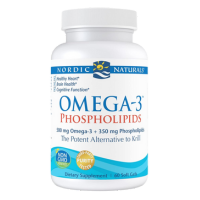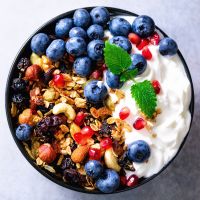Rhonda Patrick, a cell biologist, has emerged as a noteworthy public educator on nutrition, aging, brain health and cancer prevention/management/treatment. She is known for her ability to demystify complex scientific topics making them accessible to the average person.
Of the roughly dozen or so supplements she takes daily, fish oil is among the ones she talks about and roots for the most. During podcasts, blogs, interviews and on other media, Rhonda has shared important insights on her fish oil protocol including the brands she prefers.
We take a look at these as well as the useful tidbits that provide a better understanding of her position on fish oil supplementation and diet.
When She Started Taking Fish Oil
Considering that she was born in 1978, we can deduce that Rhonda started taking fish oil around 2008 when she was about 30 years old. We can calculate this on the basis of a conversation she had with the host of The Tim Ferriss Show in June 2017. Here, she disclosed she had been taking fish oil daily for nine years.
Rhonda takes fish oil for its high degree of marine omega-3 fatty acid content (i.e. eicosapentaenoic acid (EPA) and docosahexaenoic acid (DHA)). So throughout this article, we will use fish oil and omega-3 interchangeably.

She does concede that she takes a much larger quantity of fish oil in both food and supplementation form than the average person. In fact, Rhonda has been so consistent in her intake that her omega-3 index level stands at 16% which she says is about 4 times higher than the average American’s.
The omega-3 index is a percentage of omega-3 fatty acids (specifically EPA) in a person’s red blood cells as a proportion of their total fatty acids. Scores of 8% or higher are associated with better health.
Why She Takes Fish Oil
Fish oil is rich in the marine omega-3 fatty acids, EPA) and DHA. Rhonda takes fish oil supplements primarily as a means to foster brain health. She cites studies that show approximately 8% of the brain’s weight is omega-3. As proof of its cognitive benefits, Rhonda points to the near unanimity of existing research confirming its role in brain health, nerve growth and cognition.
“The number of studies that demonstrate optimizing omega-3 intake has some effect on cognition or behavior are extremely diverse.”
“EPA is a powerful anti-inflammatory fatty acid that has been shown to lower brain inflammation. DHA is a critical component of the cell membrane and makes up about 30% of cell membrane in the brain.”
She references research on DHA and EPA levels in red blood cells that found a correlation between a higher omega-3 status and having a 2 cm larger brain volume.
“Getting and keeping omega-3 in the brain is definitely a brain aging (delay) priority for me.”
Rhonda goes into even greater detail on the studies backing omega-3’s impact on cognitive function:
“For example, supplemental fish oil in the form of 2 grams of DHA per day has been shown to mitigate mild cognitive impairment after 4 to 17 months.
Fish oil has also been shown to slow the aging process in general. For example, fish oil supplementation of 2.5 grams per day has been shown to slow aging and lower markers of oxidation in blood cells in overweight older and middle aged adults.
In another study, supplemental fish oil of 1 gram per day increased muscle mass, grip strength, upper and lower body strength and leg power in older women in 6 months. Another study showed 3 grams of fish oil increased resting metabolic rate, exercise energy expenditure, rate of fat oxidation and lean mass while reducing cholesterol levels.”
Her Current Fish Oil Supplement Protocol
Speaking to Tim Ferris, she confirmed that fish oil is a core supplement for her that she takes daily. In a 2023 interview on the Huberman Lab podcast, Rhonda said she takes a total of 4 grams of marine omega-3 from fish oil. The dose is split into 2 grams of EPA in the morning and 2 grams of DHA in the evening.
She however told Andrew Huberman that it’s not necessary for one to split the EPA and DHA doses – she only started to do so because the supplement brand she likes provides EPA and DHA as separate supplements.
It’s not clear what supplement brand she was referring to in this 2023 podcast given that in her interview with Tim Ferris about 6 years prior, she claimed to have long used a brand that combined EPA and DHA in a single product (more on the brands she takes in the next section).
That said, Rhonda has in recent months published and updated a spreadsheet showing the quality and quantity of EPA and DHA among major supplement brands as tested and certified by the International Fish Oil Standards (IFOS). I could not however find any information stating that she had switched from her previous preferred brand and, if so, what her new recommendation is.
What Brands She Uses
Rhonda told Tim Ferris that she takes two gel capsules of Nordic Naturals Omega-3 Phospholipids. She states that the omega-3 contained in this supplement has been isolated from herring roe.
“The DHA is in a specific form that has been shown to be taken up by the brain best. This is also the form you can get if you get a krill oil supplement as well.”
During the same interview, she also mentioned taking four capsules of Nordic Naturals ProOmega 2000. She does not expound why but I would think it’s part of her overarching philosophy of lifting and maintaining her omega-3 index levels considering both Nordic Naturals’ products contain EPA and DHA.
You can order:

She opts for Nordic Naturals products for their production quality.
“They are NSF certified which is one of the certifications for quality. My understanding is that they also isolate their fish oil under nitrogen conditions meaning no oxygen present so as to minimize any oxidation during the isolation process. They are by no means the only option out there but I felt pretty good about using their product and I have used them for many years.”
Her Dietary Sources of Omega-3
While Rhonda takes fish oil supplements every day and has done so for years, she frequently talks about the importance of a healthy diet as the primary source of the omega-3 nutrients the body needs. And she went ahead to share her elaborate dietary plan during a Tim Ferris podcast.
Salmon roe caviar
When it comes to fish oil-rich foods in particular, Rhonda recommends taking salmon roe caviar given that it has 438 mg of EPA and 514 mg of DHA per ounce. Further, she says the fats are in phospholipid form which means a greater bioavailability for onward transportation to the brain.

Nut and berry cereal
She takes a nut and berry cereal each morning that contains walnuts and macadamia nuts. These nuts as well as flax seed (which she takes each morning as well) provide multiple nutrients. In the context of our conversation here, they are a source of the omega-3 fatty acid, alpha linolenic acid (ALA).

Rhonda is quick to note that ALA, the plant-based omega-3 fatty acid, is not a substitute for the marine omega 3 fatty acids found in fish oil and should therefore not be taken to compensate for a low EPA and DHA intake.
Fish Oil Supplementation Safety Precautions
Rhonda emphasizes that fish oil supplements are exceptionally sensitive to the quality of production, handling and packaging. It’s essential that one watches for quality and only buys from a reputable and trustworthy brand.
“It should be kept refrigerated and not arrive already too oxidized. In fact, varying degrees of fish oil oxidation is of great concern to the scientific community and scientific study design. If researchers fail to use fish oil of high quality, weird and mixed results surrounding supplementation can very well be expected. This is a characteristic that is sort of unique to fish oil unfortunately.”
As far as recommended daily intake goes, Rhonda indicates that the Food and Drug Administration (FDA) talks about 4 grams per day to be the ideal amount. However, she states this does not mean 4 grams is the ceiling of safe use. Instead, Rhonda believes one can take considerably more than this amount with no adverse effect.
I found that the Office of Dietary Supplements has 1.1 to 1.6 grams as the optimal dose for EPA supplementation with 3 grams as the upper band of safety. I did not find a similar guideline for DHA supplementation.
Wrapping Up
Rhonda’s deep understanding of omega-3’s nutritional benefit is a key reason she is an associate scientist at the Fatty Acid Research Institute. In this role, she is involved in investigating omega-3 fatty acids’ impact on aging and brain health. Her views on fish oil therefore carry more weight than most.
And she does not just talk about it – she has lived it via a fish oil supplement routine lasting more than 15 years. Importantly, Rhonda regularly reminds her audience that fish oil supplementation does not replace a diet rich in marine omega-3.

